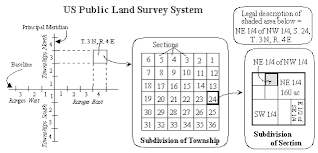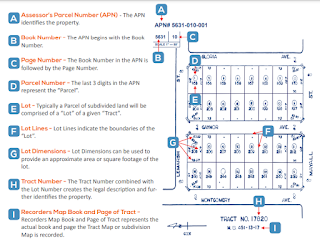The original means of property descriptions and measurements in the US was the metes and bounds method. Metes and bounds was originally used in England for centuries then brought to the US with the first colonies. The "metes" are the length of the runs in a direction and the "bounds" are the boundaries. Below is an example of an older metes and bounds description of property one might find in a 17th century US land deed.
"Commencing at a corner at the intersection of two stone walls near an apple tree on the north side of Muddy Creek road one mile above the junction of Muddy and Indian Creeks, thence north for 150 rods to the end of the stone wall bordering the road, thence northwest along a line to a large standing rock on the corner of the property now or formerly belonging to John Smith, thence west 150 rods to the corner of a barn near a large oak tree, thence south to Muddy Creek road, thence down the side of the creek road to the point of commencement."
Modern day property measurement and description use the government survey system or Public Land Survey System PLSS. The PLSS system is based on set principle meridian and base lines across the US based on exact locations using longitude and latitude. Using the base lines the land is divided into sections, townships and ranges, see image above.
A section is one-square-mile block of land. There are 36 sections in a survey township. A township is a square parcel of land of 36 square miles, or a measure of the distance north or south from a referenced baseline, in units of six miles. See image below.
An example of the PLSS description would be "the Northeast quarter of the Northeast quarter of Section 10, Township 3 South, Range 68 West of the 6th Principal Meridian, Arapahoe County, Colorado" or "NE/4 NE/4 of Section 10, T-3-S, R-68-W, 6th P.M., Arapahoe County, Colorado."
In the city the most common type of legal property description and measurement is the subdivision tract, lot and block method. After describing land using PLSS it's further divided into smaller tracts of land which are then divided into lots and blocks via plat maps. A plat map, also known as a “plat,” shows you how a tract of land is divided into lots in your county. It is drawn to scale and records the land's size, boundary locations, nearby streets, flood zones, and any easements or rights of way. A plot map is a single plot or piece of land. Below is a description of real property using the subdivision and lot names and numbers. Subdivisions or tracts can have regular names such as "Highland Park" or use numbers.
Lots 6, 7, and the South ½ of Lot 3, West 60 feet of South ½ of Lot 4, West 60 feet of Lot 5 and Lot 8, Block 20, OLD SURVEY, Leesville, Vernon Parish, Louisiana.
If it were just one full lot in a subdivision, the description could be just TRACT # 14386 LOT 286.
We also use the Tax Assessor Parcel Number (APN) to describe property. The APN uses the Tax Assessor’s Book Number, Page Number and the individual Parcel Number. An example of a parcel number in Los Angeles county would be 4248-005-021 where the first four numbers are the book number, next three are the book page number and the last number is the parcel number. Below is an image which explains Los Angeles County plat maps. Click to see larger.
Here's a specific example of a Los Angeles county legal description and APN. I'm using a property that includes parts of two lots to make it more complex. The legal description is "WESTMORELAND HEIGHTS TRACT S 41 FT OF LOT 43 AND N 20 FT OF LOT 44." This is an old tract so it has a name instead of a number. The Assessor's Parcel Number is 5074-019-004. The last number of the APN is in the pink circle, i.e. 4. The red arrow is pointing to the specific piece of land. It's the south 41 feet of lot 43 and the north 20 feet of lot 44. You can see the measurements on the lot lines, i.e. 20' x 41'. You see a lot tie or hook symbol in between lots 43 and 44 which shows the lots are tied together. It looks like a tall "Z" like this image and can be angled like an italic "Z." Click images to see larger.
When you buy real estate you are actually buying only the land. Legally this entitles you to anything permanently affixed to the land. If you look at a real estate deed you will only see the legal description and the tax assessor parcel number. You don't see a description of the home or any other structures on the land. In the US the main types of land descriptions and measurements are the Public Land Survey System PLSS, lot & block description and tax assessor parcel map and numbers.
Mary Cummins of Animal Advocates is a wildlife rehabilitator licensed by the California Department of Fish and Game and the USDA. Mary Cummins is also a licensed real estate appraiser in Los Angeles, California.
- Mary Cummins LinkedIn
- Mary Cummins Meet up
- Animal Advocates custom Facebook name
- Mary Cummins Real Estate blog
- Animal Advocates on Google maps
- Mary Cummins of Animal Advocates
- Mary Cummins biography resume short
- Mary Cummins Real Estate Services
- Animal Advocates fan page at Facebook.com
- Mary Cummins Animal Advocates Squirrel Rescue
- Mary Cummins Animal Advocates on Flickr photos
- Mary Cummins Animal Advocates on Twitter.com
- Mary Cummins on Picasa web photo albums
- Mary Cummins on MySpace.com
- Mary Cummins on Google Blogger Blogspot
- Mary Cummins on YouTube.com videos
- Mary Cummins of Animal Advocates on Classmates
- Mary Cummins on VK
- Mary Cummins of Animal Advocates on Google+







No comments:
Post a Comment